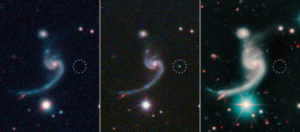A massive star lost most of its mass before exploding and creating a neutron star — and a second nearby neutron star might have been the thief.

SDSS / Caltech / Keck
Last year, a tsunami of gravitational waves washed over Earth, heralding the collision of two neutron stars in a far-off galaxy. Such collisions appear to the birthplace of many of the heaviest elements such as gold, platinum, and uranium.
Now, an unusual, rapidly brightening supernova might help researchers understand how such neutron star duos arise in the first place. “This is the first example of a supernova that produced a compact binary system that is tight enough to eventually merge and produce gravitational (and even electromagnetic) waves,” says Kishalay De (Caltech), lead author on a study published in the October 12th Science.
The supernova, designated iPTF14gqr, went off in the outskirts of a galaxy just over 900 million light-years away. It was detected in October 2014 by the intermediate Palomar Transient Factory, an automated search at Palomar Observatory for anything flashing or flickering in the night sky.
Right away, this supernova seemed odd. Most supernovae take a few weeks to hit their peak brightness — this one did so in less than 7 days. The reason it usually takes longer is that there is typically a lot of material in the way for the light to get through. A rapid brightening suggests a relative paucity of debris.
The researchers estimate that iPTF14gqr released only one-fifth of the mass of the Sun — most supernovae expel several Suns worth of gas. What’s more, the team deduced that the star was about 1.5 times as massive as the Sun shortly before the explosion. But for a star to go boom, its original mass needs to be at least eight times as massive as the Sun.
Something must have stripped the star of most of its mass. The most likely candidate, the team argues, is a second neutron star.
Here’s how the researchers think the story played out: Two massive stars once orbited each other. One of them reached the end of its life and exploded, leaving its core behind as a neutron star. This neutron star then stripped its companion of most of its gas. By the time the second star exploded — and became known as supernova iPTF14gqr — there wasn’t much gas left. This explosion also left behind a neutron star, leaving two neutron stars in a tight orbit.
“I am extremely excited,” says Thomas Tauris (Aarhus University, Denmark), who was not involved in this study, but helped lay down much of the theoretical groundwork underpinning the discovery. “These ultra-stripped supernovae were first discovered on our computers in Bonn as a pure theoretical concept, so it is really fantastic that observers can now verify their existence in detail.”
Both De and Tauris caution that the true nature of the thief that stole this star’s gas is a little uncertain. “Whether [it’s] a white dwarf, a neutron star, or a black hole, we cannot tell,” Tauris says. The sheer amount of mass loss leading up to the explosion implies an intense gravitational pull from something very close, De says, and a neutron star fits that description. Tauris also argues that a neutron star is the most likely culprit based on what astronomers know about how common the progenitors of neutron stars are in the universe.
At nearly 1 billion light-years away, the high-energy radiation from any putative neutron stars is much too faint to detect, says De, making it impossible to look for direct evidence of what the supernova left behind. “Perhaps some day we will see such an event in a nearby galaxy, within say 50 million light-years. Then there might be interesting tests to try.”
Reference:
K. De et al. “A hot and fast ultra-stripped supernova that likely formed a compact neutron star binary.” Science. October 12, 2018.
 1
1









Comments
Jim-Baughman
October 19, 2018 at 4:32 pm
Any estimate yet of how far apart these objects are from each other? Even if they are very close it would take many millions of years for them to merge.
You must be logged in to post a comment.
You must be logged in to post a comment.